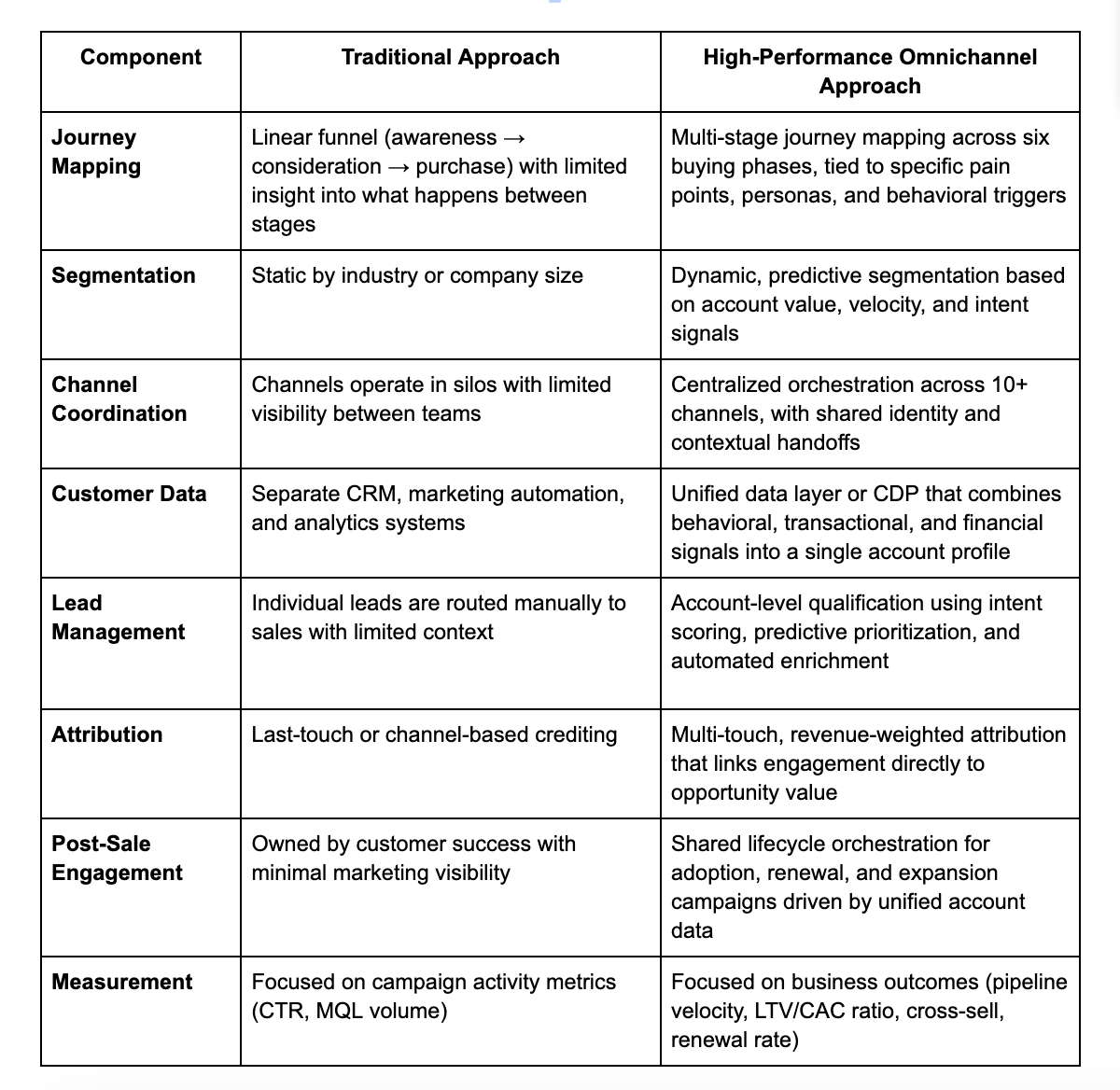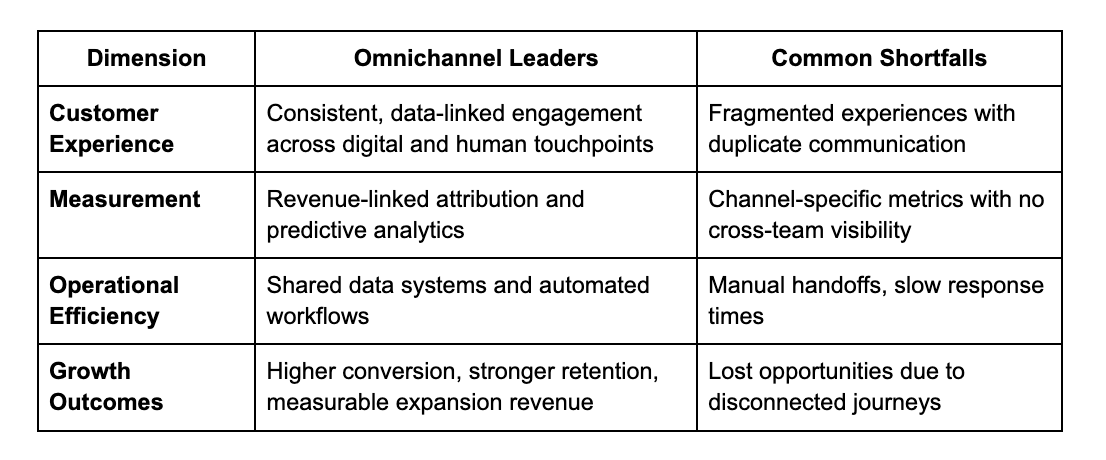Buyers expect fluid, consumer-grade purchase paths, even in B2B. But because ownership of different marketing channels is siloed (each with its own wealth of data sources), it’s near-impossible to attribute value precisely.
Yet amid those challenges lie new opportunities.
Advances in real-time data integration, AI-driven modeling, and commerce media enable more precise targeting and measurement. And when configured properly, omnichannel systems can shorten cycles, raise win rates, and deepen customer engagement post-sale.
Below, we walk through how to build an omnichannel engine that acquires enterprise customers at scale and sustains growth in complex environments.
B2B Omnichannel Marketing Fundamentals: Beyond Multi-Channel to Unified Customer Experience
Many B2B teams confuse multi-channel with omnichannel — but they’re not the same.
Multi-channel simply means having a presence in many places. Omnichannel, on the other hand, means that your messaging, positioning, and branding are consistent in all of those places. Users should have a unified experience, whether they’re viewing a LinkedIn ad, blog, or interactive demo. And that should carry through to their first sales call, onboarding, and ongoing customer success.
How B2B Buyer Behavior Evolved
According to McKinsey, today’s B2B buyers use an average of ten interaction channels in their buying journey — up from just five channels in 2016.
Expectations are higher, too. More than half of leaders surveyed want a true omnichannel experience, where they can interact with brands and buy across many different channels, oscillating between research, evaluation, and validation. If they don’t have a smooth experience, they’ll switch suppliers.
Strategic Integration Requirements and Limitations
The problem is that, to align channels, companies need to unify identity, session, and profile layers across these touchpoints. And that’s hard.
Legacy CRMs and marketing automation often fragment identity (one system sees web visits, another sees sales calls, and yet another sees product usage), and teams deploy channel-level KPIs independently.
That means that, without cross-channel orchestration, social teams, content teams, and demand gen teams are just optimizing their piece instead of the whole picture. As a result, buyers repeat steps, lose context, or abandon the buying process altogether.
Enhanced Omnichannel Signals
A key differentiator lies in embedding financial signals — pipeline, deal stage, contract value, churn risk — into marketing decisions. If a campaign can prioritize engagement with accounts already at high revenue potential, marketers avoid waste.
For instance, rather than allocating budget by channel volume (e.g., impressions, clicks), you weight by pipeline impact and lifetime value (LTV). You can build propensity models that forecast which accounts will drive $X more in the next 12 months, and allocate campaigns accordingly.
When marketers see not just clicks, but deal influence and revenue correlation, they can prune underperforming pathways and double down on high-leverage ones.
Takeaway for Enterprise B2B Brands
Omnichannel in B2B demands more than presence in many channels. It requires unity: identity, context, revenue linkage, and orchestration. As buyer expectations shift, your system must evolve from patchwork to a continuous, profitable conversation.
Strategic Business Impact: ROI and Performance Advantages of B2B Omnichannel Excellence
Omnichannel systems can drive substantial returns in all aspects of the business, including:
Customer Retention
Omnichannel systems close the gap between marketing, sales, and service, enabling fast, coordinated responses across every channel. That responsiveness strengthens trust.
Studies show closing the loop within 48 hours can raise customer retention by 12%. In B2B, where contracts and renewals hinge on reliability, that connected responsiveness is what keeps customers from drifting to competitors.
Revenue Growth
By reducing friction, improving consistency, and meeting buyers where they are, firms accelerate sales cycles and close more deals. Per McKinsey, B2B companies that provide the best omnichannel experience are improving their market share by at least 10% annually.
Post-purchase Expansion & Cross-sell
An omnichannel system doesn’t shut down after the deal. After-sale engagement (training, adoption nudges, support content) can identify upsell opportunities or renewals.
B2B companies that orchestrate these touchpoints see higher cross-sell and upsell rates. Deloitte notes organizations with holistic omnichannel views are 3.6x more likely to secure cross- and upsell.
Acquisition Benefit via Superior Attribution
When your attribution is weak, it’s easy to over- or under-invest in specific marketing channels.
Omnichannel attribution connects exposure, engagement, and conversion across every touchpoint, revealing which interactions truly drive revenue. Instead of crediting last click, revenue-linked attribution assigns proportional value to each step in a multi-month buying cycle.
That clarity helps teams invest in the channels that actually move deals forward, increasing ROI and decreasing cost per acquisition.
Essential Strategy Components: Building High-Performance B2B Omnichannel Systems
To build a world-class omnichannel system, you need architecture, alignment, and rigorous operating design, including:
Journey Mapping and Advanced Segmentation
Begin by mapping the six major stages:
Search → Compare & Select → Purchase & Production → Delivery & Install → Invoice & Payment → After Sales
Accenture documented over 1,600 distinct pain points across that journey, with 85% rooted in reliability, convenience, transparency, and responsiveness. Mapping these touchpoints helps teams see exactly where buyers stall, where information breaks down, and where intervention matters most.
Build persona-specific maps that show which channels each role (champion, user, influencer) uses at each stage. Then cluster accounts by value, expansion potential, and buying velocity. Use predictive scoring models to forecast which accounts need high-touch orchestration from sales versus automated nurture flows from marketing.
Technology Integration & Alignment
You need a unified data layer that collects events, transactions, interactions, usage, and financials into a single profile. Often, this is a customer data platform (CDP), like Segment.
From that profile, you can see what each person at each account searched for, downloaded, clicked, or purchased, allowing marketing to trigger context-specific outreach across email, web, ads, and chat.
Go-to-market teams should all share this view so that sales can see what content may have already influenced a buyer, and marketing can monitor pipeline progress and adjust campaigns based on live usage data.
Strategic Lead Management & Enhancement
Lead handoffs should be account-aware, not purely lead-based. In practice, that means marketing:
- Identifies accounts high in buying intent
- Injects personalized campaigns
- Hands over enriched accounts (with personas mapped) to revenue teams
These leads must provide sellers with context — where the prospect is in their buying journey, their requirements, and how they’ve already interacted with the brand. Here are some ways to refine this process:
- Use explainable AI scoring models to prioritize accounts based on usage changes, product signals, or churn risk.
- Leverage predictive intent data from web behavior or content engagement to decide whether an account should move into nurture or sales outreach.
- Reengage dormant accounts dynamically through automated, behavior-based reactivation campaigns that personalize offers or content.

Campaign Execution Excellence: Tactical Implementation and Multi-Channel Coordination
Once your foundation exists, execution becomes the differentiator. Here’s how to tie channels, automation, and measurement into a high-performance campaign engine.
Channel Integration Strategy & Automation
Select a marketing automation platform that can serve as a central orchestration hub, such as HubSpot, Pardot, or Marketo, and use that hub to schedule messages, trigger handoffs, segment audiences, and sync with sales systems.
Note: This hub must be able to ingest signals from video, email, social, mobile, search, chat, and web, then trigger personalized follow-ups.
Once the infrastructure is in place, the next step is choosing the channels that will drive performance. Automation only works when it amplifies the right inputs. In other words, your success depends on selecting and coordinating the channels that align with how your buyers actually research, evaluate, and decide.
For B2B, high-performing channels often include:
- Google and LLM search
- Content syndication
- Programmatic display
- Event and webinar follow-up
- Retargeting and account-based ad campaigns
Use early metrics (lead rate, cost per MQL, engagement time, velocity to opportunity) to prune underperformers and reassign budget mid-campaign. Use AI or automated rules to shift spend dynamically.
Five-Step Enhanced Execution Framework
Adopting a project management rhythm helps ensure communication, contingency, and iteration throughout the campaign lifecycle. Here’s a sample to follow:
- Initiation. Define campaign objective, target accounts, personas, KPIs, and timeline.
- Planning. Select channels, message flows, content assets, budgets, and risk mitigation.
- Execution. Launch campaign, monitor systems, log exceptions or drop-offs.
- Monitor & Control. Compare performance against benchmarks, make real-time adjustments, escalate issues, and shift budgets.
- Closing. Analyze results, archive assets, and identify ways to reuse or expand the campaign.
Campaign Integration Benefits & Enhancements
Because every campaign shares the same identity and data layer, you reduce conflicting messages, redundant reach, and wasted exposure. Teams align on fewer themes, execute fewer but higher-impact campaigns, and avoid silos.
You can embed financial triggers (e.g., only launch expansion outreach on accounts whose LTV exceeds a certain threshold) and use adaptive content rotation based on engagement heat maps.
Data Analytics and Attribution: Performance Measurement and Customer Acquisition Intelligence
Delivering measurable, defensible results hinges on unified data and advanced attribution. A real-time CDP acts as your nervous system. It merges behavioral events (site visits, content views, email opens), transactional records, usage logs, CRM entries, and financial outcomes.
From that unified view, you can activate segments, feed predictive models, and trace touchpoints through to account outcomes. You can also apply attribution models suited for long, committee-driven B2B cycles:
- W-shaped (credit split across first touch, lead creation, final touch)
- Data-driven attribution
- Markov chain models
These distribute credit more fairly across influences, rather than defaulting to last-click. Simpler models may lack nuance, while complex ones demand departmental trust and transparency.
Performance Measurement & Feedback Loops
Track acquisition with metrics that link marketing investment to real business impact, like:
- Customer Acquisition Cost (CAC)
- Lead to Win Rate
- Visitor to Lead Conversion Rate
- LTV / CAC ratio
Benchmark performance against your industry to understand efficiency and competitiveness. Build a closed-loop feedback system where marketing channels feed attribution data, sales report outcomes, and insights flow back into campaign design.
This is where many teams struggle. Too many variables can distort attribution:
- Cross-device identity gaps (anonymous web traffic that later becomes known accounts)
- Offline touches like calls, meetings, and events
- Multi-account influence within large buying groups
- Lengthy or shifting sales cycles with new stakeholders entering midstream
Design your attribution model to be both defensible and iterative. Start simple, validate accuracy, then add layers of sophistication over time. When ready, incorporate revenue-weighted attribution to give greater credit to campaigns that influence larger opportunities.
Use pipeline import to link marketing touchpoints directly to opportunity records. When deterministic tracking isn’t possible, apply probabilistic models to distribute fractional credit across all credible influences. This doesn’t have to be perfect, it just has to help you make smarter marketing investments.
Industry Success Stories: B2B Omnichannel Excellence and Strategic Enhancement Opportunities
Even the most complex B2B operations can deliver unified, consumer-grade experiences. Amazon’s omnichannel strategy connects digital and physical environments so buyers can interact however they prefer: online, in-store, even by voice.
Services such as Amazon Go (cashier-less shopping), Amazon Prime (loyalty and delivery benefits), and Alexa voice ordering demonstrate how channel integration can feel invisible to the customer. Each touchpoint shares a common data layer that drives personalized recommendations, pricing, and service at scale.
Amazon Business brings this same continuity to B2B procurement. The platform merges consumer simplicity with enterprise controls: multi-user accounts, custom approval workflows, and multi-channel fulfillment for fast, reliable delivery.
The takeaway: Omnichannel excellence is not about adding more channels. It’s about unifying data, context, and fulfillment so that every channel reinforces the next.
Where Other Kinds of B2B Businesses Can Shine
The SaaS Feedback Loop Advantage
Top SaaS companies apply the same principles to digital customer lifecycles. They integrate web, in-product, email, and support channels within a single engagement system, powered by Customer Data Platforms (CDPs) and AI-driven personalization.
This unification allows marketing and product teams to collaborate around the same behavioral data: who trialed, who activated, and who might churn. The outcome is consistent engagement that improves trial-to-paid conversion, reduces acquisition cost, and drives retention.
Retail B2B Innovation
Industrial and wholesale distributors now deliver B2B experiences that mirror retail convenience. Digital catalogs, mobile reordering, embedded chat, and ERP integrations combine to streamline procurement while keeping complex pricing and terms intact.
Companies that combine ecommerce, field sales, and financing within the same data infrastructure improve efficiency, reduce manual quote errors, and accelerate fulfillment.

Future Trends and Strategic Enhancement: Next-Generation B2B Customer Acquisition
The next evolution of B2B omnichannel marketing won’t come from adding more tools or channels. It will come from artificial intelligence.
AI-Powered Orchestration and Predictive Targeting
AI models trained on behavioral and financial data can now predict which accounts are most likely to buy, what content will resonate, and when outreach will have the most impact.
When this intelligence powers coordinated channels — email, social, content, chat, events — it drives measurable lift. Companies that use predictive targeting across multiple touchpoints have reported up to 74% higher engagement rates.
Intelligent Journey Analysis
AI-driven journey analytics platforms now monitor buyer behavior across every interaction, mapping pathways that lead to closed deals versus those that stall. Systems like Adobe Customer Journey Analytics and TheyDo use natural language and machine learning to identify friction points, surface next-best actions, and reallocate resources dynamically.
This helps:
- Marketers anticipate objections
- Sales teams better time their outreach
- Revenue leaders understand where growth will come from next
AI-Driven Content and Engagement Optimization
Generative AI is accelerating content production and personalization at scale. Instead of building one-size-fits-all campaigns, marketers can create modular assets that adapt to persona, stage, and engagement pattern. AI systems test variations continuously, learn which formats and tones perform best, and adjust messaging automatically.
Autonomous Revenue Systems
By 2025, up to 80% of routine B2B sales engagements — from outreach sequencing to account enrichment — will be automated. Marketers will guide models with context, creativity, and ethical oversight, while AI handles the speed, timing, and precision.
Build Toward Continuous, Connected Growth
B2B buyers expect seamless transitions between channels, full context preservation, and consistent digital-human continuity. But many B2B teams struggle to implement a true omnichannel strategy.
The right approach is incremental.
Start with a pilot that connects two or three core channels. Test your revenue attribution, align GTM around shared performance metrics, and use what you learn to expand gradually, linking more channels, enriching data, and refining your orchestration.
Frequently Asked Questions About B2B Omnichannel Marketing
What is B2B omnichannel marketing, and why is it important?
B2B omnichannel marketing coordinates all sales, marketing, and customer success channels to create a seamless, consistent experience for customers across platforms like email, social media, websites, and in-person interactions. It is crucial due to longer sales cycles, multiple decision-makers, and the need for personalized relationship-building in B2B spaces.
Can you give real-world examples of B2B omnichannel marketing?
Examples include SaaS companies using webinars and live chats, manufacturing firms combining digital catalogs with virtual tours, and professional services leveraging thought leadership across digital and traditional channels.
What are the four types of B2B marketing and the four C's framework?
The four main B2B marketing types are product-led, sales-led, brand-led, and demand-led marketing. The four C's framework—Customer, Content, Channel, and Context—helps tailor strategies by focusing on audience needs, relevant content, appropriate channels, and timing.
What is the 95-5 rule in B2B marketing?
The 95-5 rule suggests that 95% of B2B buyers' purchase decisions are influenced by brand perception and awareness, while only 5% come directly from active sales engagement.
How does omnichannel marketing impact customer retention and revenue?
A seamless omnichannel experience increases retention by building trust and convenience, which in turn drives higher revenue through cross-selling, upselling, and long-term relationships with customers.
Why is customer journey mapping essential in B2B omnichannel marketing?
Journey mapping identifies every touchpoint, highlighting pain points and opportunities for personalized engagement across channels, helping businesses deliver consistent messaging that matches where clients are in their buying process.
How can companies overcome challenges in implementing B2B omnichannel marketing?
Key challenges include integrating multiple platforms and aligning internal teams. Solutions focus on leveraging data for personalization, ensuring consistent messaging, and breaking down silos between marketing, sales, and customer success teams.


